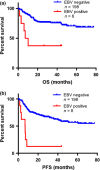Clinical outcome of Epstein-Barr virus-positive diffuse large B-cell lymphoma of the elderly in the rituximab era
- PMID: 24974976
- PMCID: PMC4462402
- DOI: 10.1111/cas.12467
Clinical outcome of Epstein-Barr virus-positive diffuse large B-cell lymphoma of the elderly in the rituximab era
Abstract
Diffuse large B-cell lymphoma (DLBCL) is the most common subtype of malignant lymphoma. The incidence of Epstein-Barr virus (EBV)-positive DLBCL in Asian and Latin American countries ranges from 8 to 10%. The prognosis of patients with EBV-positive DLBCL is controversial. To compare the clinical outcome of EBV-positive and EBV-negative patients with DLBCL in the rituximab era, we analyzed 239 patients with de novo DLBCL diagnosed between January 2007 and December 2011. The presence of EBV in lymphoma cells was detected using EBV-encoded RNA in situ hybridization, and it was found that 18 (6.9%) of 260 patients with diagnosed DLBCL tested positive. Among the 260 cases, 216 cases were treated with rituximab plus chemotherapy, as were 8 EBV-positive DLBCL patients. The median overall survival and progression-free survival times in patients with EBV-positive DLBCL were 8.7 months and 6.8 months, respectively. The median overall survival and progression-free survival could not be determined in EBV-negative DLBCL patients (P = 0.0002, P < 0.0001, respectively). The outcome of patients with EBV-positive DLBCL remains poor, even in the rituximab era.
Keywords: Diffuse large B-cell lymphoma; Epstein-Barr virus (EBV); prognosis.
© 2014 The Authors. Cancer Science published by Wiley Publishing Asia Pty Ltd on behalf of Japanese Cancer Association.
Figures


Similar articles
-
Epstein-Barr virus (EBV) positive diffuse large B cell lymphoma of the elderly-experience of a single center from Turkey.Pathol Res Pract. 2013 Aug;209(8):471-8. doi: 10.1016/j.prp.2013.04.014. Epub 2013 May 9. Pathol Res Pract. 2013. PMID: 23726928
-
Prevalence and clinical implications of epstein-barr virus infection in de novo diffuse large B-cell lymphoma in Western countries.Clin Cancer Res. 2014 May 1;20(9):2338-49. doi: 10.1158/1078-0432.CCR-13-3157. Epub 2014 Feb 28. Clin Cancer Res. 2014. PMID: 24583797 Free PMC article.
-
Clinical impact of serum survivin positivity and tissue expression of EBV-encoded RNA in diffuse large B-cell lymphoma patients treated with rituximab-CHOP.Oncotarget. 2017 Feb 21;8(8):13782-13791. doi: 10.18632/oncotarget.14636. Oncotarget. 2017. PMID: 28099151 Free PMC article. Clinical Trial.
-
Secondary cutaneous Epstein-Barr virus-associated diffuse large B-cell lymphoma in a patient with angioimmunoblastic T-cell lymphoma: a case report and review of literature.Diagn Pathol. 2012 Jan 19;7:7. doi: 10.1186/1746-1596-7-7. Diagn Pathol. 2012. PMID: 22260632 Free PMC article. Review.
-
EBV-positive diffuse large B-cell lymphoma of the elderly: 2016 update on diagnosis, risk-stratification, and management.Am J Hematol. 2016 May;91(5):529-37. doi: 10.1002/ajh.24370. Am J Hematol. 2016. PMID: 27093913 Review.
Cited by
-
Clinicopathological analysis of primary intestinal diffuse large B-cell lymphoma: Prognostic evaluation of CD5, PD-L1, and Epstein-Barr virus on tumor cells.Cancer Med. 2018 Dec;7(12):6051-6063. doi: 10.1002/cam4.1875. Epub 2018 Nov 18. Cancer Med. 2018. PMID: 30449068 Free PMC article.
-
Estimating the global burden of Epstein-Barr virus-related cancers.J Cancer Res Clin Oncol. 2022 Jan;148(1):31-46. doi: 10.1007/s00432-021-03824-y. Epub 2021 Oct 27. J Cancer Res Clin Oncol. 2022. PMID: 34705104 Free PMC article. Review.
-
Significance of trogocytosis and exosome-mediated transport in establishing and maintaining the tumor microenvironment in lymphoid malignancies.J Clin Exp Hematop. 2021 Dec 22;61(4):192-201. doi: 10.3960/jslrt.21005. Epub 2021 Jun 30. J Clin Exp Hematop. 2021. PMID: 34193756 Free PMC article. Review.
-
Clinical characteristics and prognostic significance of EBER positivity in diffuse large B-cell lymphoma: A meta-analysis.PLoS One. 2018 Jun 19;13(6):e0199398. doi: 10.1371/journal.pone.0199398. eCollection 2018. PLoS One. 2018. PMID: 29920566 Free PMC article.
-
Clinical and molecular features of Epstein-Barr virus-positive diffuse large B-cell lymphoma: Results in a multi-center trial.Clin Transl Med. 2021 Sep;11(9):e539. doi: 10.1002/ctm2.539. Clin Transl Med. 2021. PMID: 34586746 Free PMC article. Clinical Trial. No abstract available.
References
-
- Lymphoma Study Group of Japanese Pathologists. The World Health Organization classification of malignant lymphomas in Japan: incidence of recently recognized entities. Pathol Int. 2000;50:696–702. - PubMed
-
- Swerdlow SH, Campo E, Harris NL, et al. WHO Classification of Tumours of Haematopoietic and Lymphoid Tissues. 4th edn. Lyon, France: IARC Press; 2008.
-
- Gibson SE, Hsi ED. Epstein-Barr virus-positive B-cell lymphoma of the elderly at a United States tertiary medical center: an uncommon aggressive lymphoma with a nongerminal center B-cell phenotype. Hum Pathol. 2009;40:653–61. - PubMed
MeSH terms
Substances
LinkOut - more resources
Full Text Sources
Other Literature Sources
Medical

